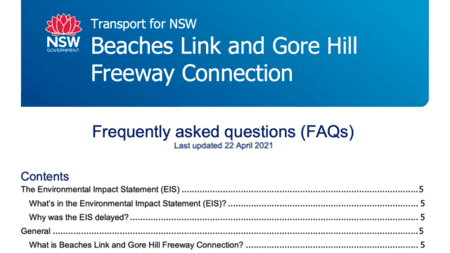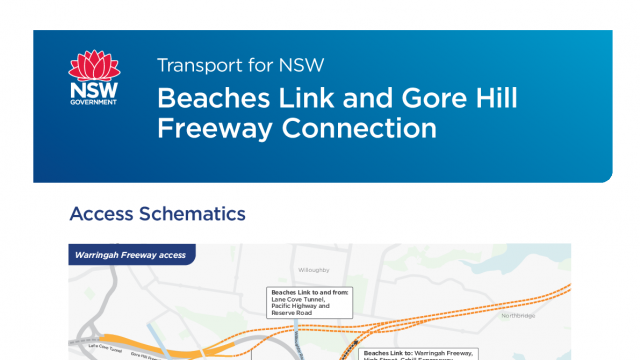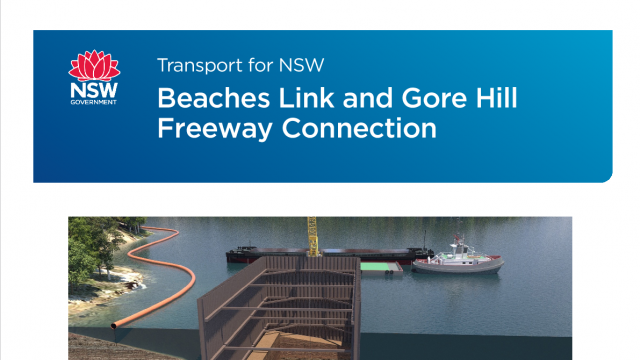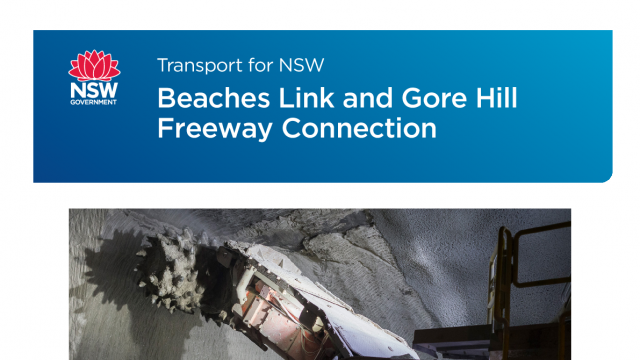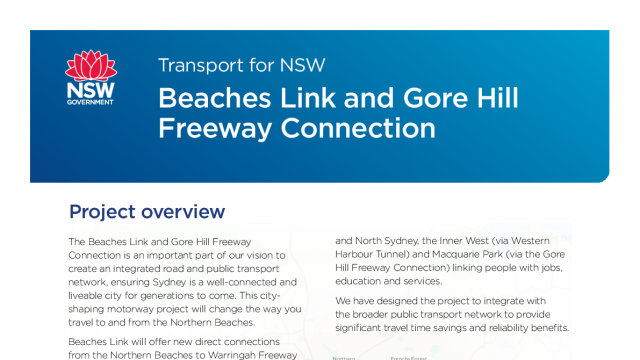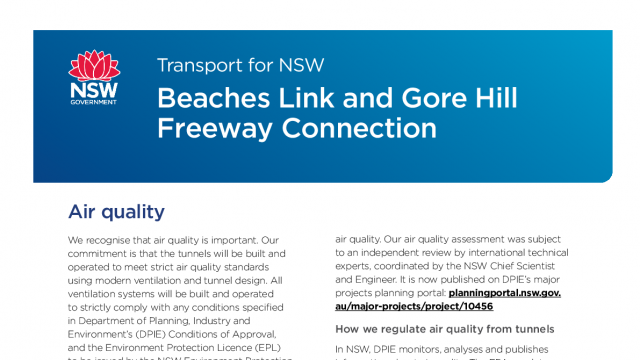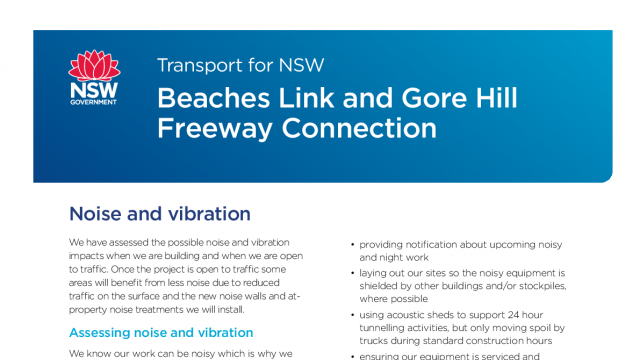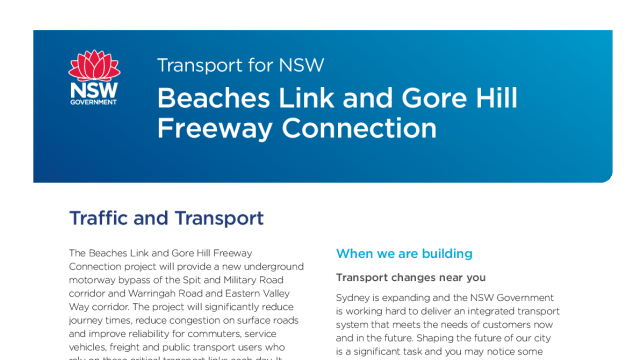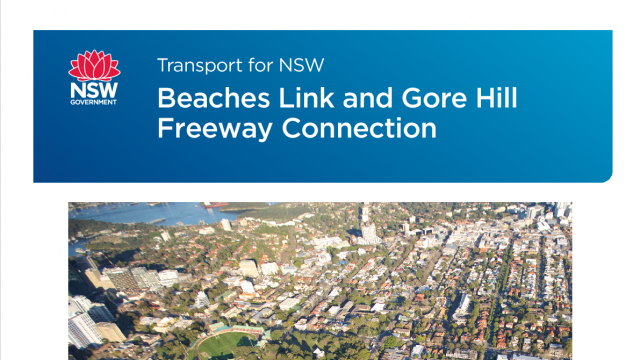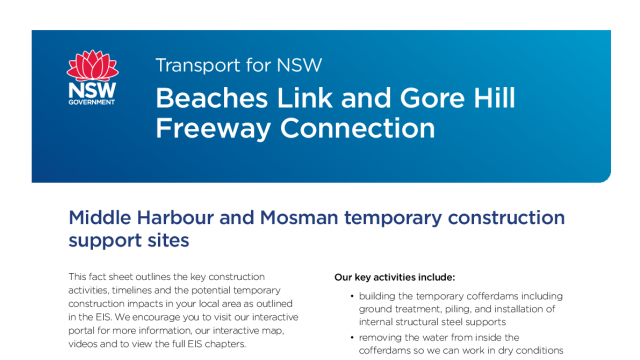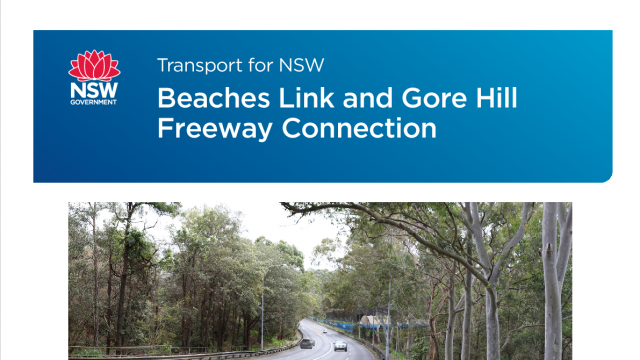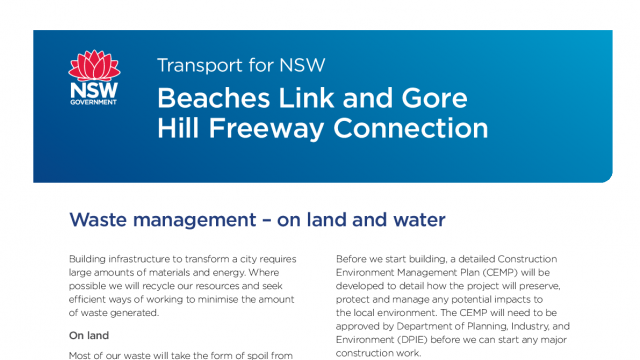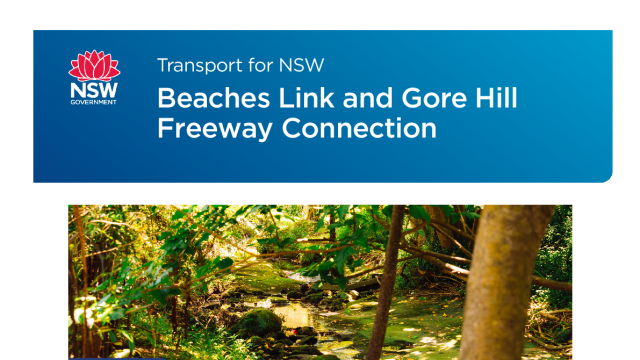Documents
Select any of the documents below to download. Please check back here for updates as the project progresses.
EIS chapters Filter EIS by topic EIS fact sheets Earlier documents NotificationsEIS chapters
EIS appendices
Fact sheets
Earlier documents
Notifications
Before/After: Miller Street Bridge
Drag the slider from the left to right to compare the existing road layout with the design.
Share this: Share on Facebook Tweet on Twitter

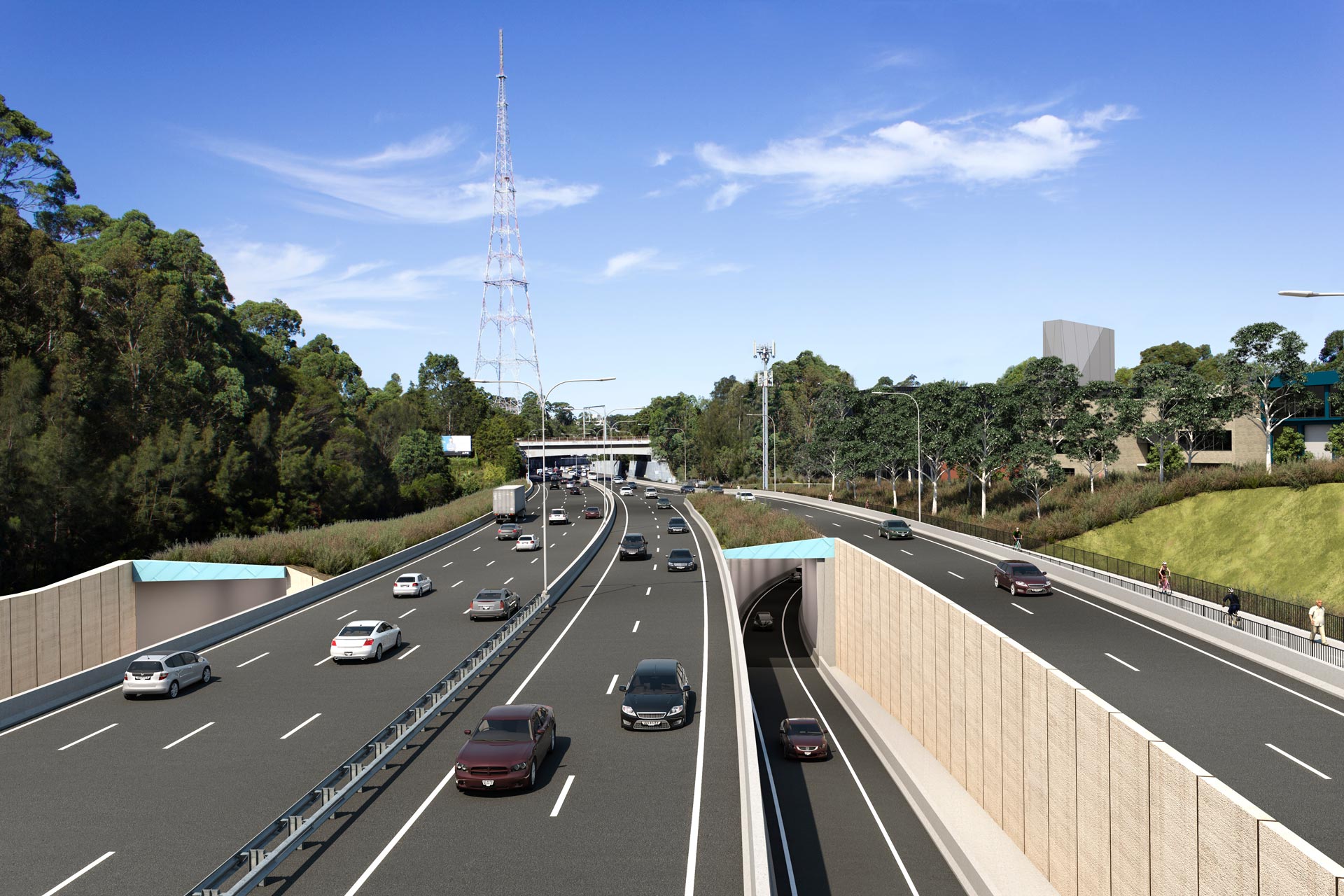
Artarmon

Balgowlah

Balgowlah

Cammeray

Northbridge/Willoughby

Middle Harbour

Wakehurst Parkway

Seaforth
Filter the EIS
Select the topics you are interested in reading about
Related chapters
Select from topics of interest above
Mosman/Middle Harbour
8 February 2021
Northbridge/Willoughby
8 February 2021
Seaforth/Killarney Heights/Frenchs Forest
9 February 2021
Air Quality session
9 February 2021
Cammeray
10 February 2021
Balgowlah
10 February 2021
Seaforth/Killarney Heights/Frenchs Forest
19 January 2021
Northbridge/Willoughby
19 January 2021
Balgowlah
20 January 2021
Mosman/Middle Harbour
20 January 2021
Welcome to the Beaches Link and Gore Hill Freeway Connection portal
This dedicated interactive portal contains the latest information, maps and videos about the Beaches Link and Gore Hill Freeway Connection project.
If you are looking for information about the Warringah Freeway Upgrade or Western Harbour Tunnel, please visit the dedicated project portals:
Warringah Freeway Upgrade portal Western Harbour Tunnel portal
If you have any complaints or enquiries, please contact us.
Welcome to the Beaches Link and Gore Hill Freeway Connection EIS map
Explore our interactive map to see the project alignment and key information about the proposed design and construction of the project.
Please note: This interactive map contains information from the Beaches Link and Gore Hill Freeway Connection Environmental Impact Statement (EIS) which was published in December 2020. Since then, our project design and planning has continued to progress, including the release of the Submissions and Preferred Infrastructure Reports in November 2021.
For the latest project information, please visit the documents section of our portal or contact our team.
Make a submission
To make a submission on the Beaches Link and Gore Hill Freeway Connection Environmental Impact Statement, use the online form. All submissions received will be placed on the DPIE website.
The public consultation and submission period closes on 11.59pm, Monday 1 March 2021.
For a video tutorial on how to make a submission on the DPIE website click here.
To watch a video tutorial about how you can subscribe to receive timely, project-related alerts click here.
If you want DPIE to delete your personal information before publication, please make this clear at the top of your letter.
At-property noise treatment
We understand noise can be a source of disruption to local communities during the construction and operation of major road projects. To minimise the impact of our project on local residents, we are delivering at-property noise treatment to eligible properties. Noise treatment refers to architectural acoustic measures which aim to improve the sound resistance of properties, such as window and door upgrades.
We have developed a Noise Insulation Program which outlines the criteria and process for delivering noise treatment to affected properties as part of the project.
Providing at-property treatment is a complex process and involves a number of different steps. To learn more, see our fact sheet.
We are starting the process of delivering noise treatment before the project is approved so residents benefit from reduced noise as early as possible.
RSVP for a virtual information session
RSVP for a virtual information session
Virtual information sessions
We are committed to continuing to work with you and to adapting to the changing circumstances around COVID-19.
Reservations for the February 2021 sessions have now closed. You can watch the recorded sessions online by clicking on the button below.
Western Harbour Tunnel and Warringah Freeway upgrade Tender Hub - Contact us
We are happy to coordinate virtual tutorials to explain the tools and techniques of the model as required.
Please raise a question in the RFT Data Room should you require any additional support.
Contact the Beaches Link team
What is an EIS?
The EIS assesses the potential environmental and social impacts of the Western Harbour Tunnel and Warringah Freeway Upgrade during construction and operation. The EIS also includes strategies to avoid, mitigate and manage the potential impacts of the project.
In the EIS, we cover topics such as traffic and transport, air quality, noise and vibration, construction and biodiversity impacts.
The NSW Department of Planning, Industry and Environment (DPIE) placed the EIS on exhibition from 29 January to 30 March 2020. This closing date was extended from 12 March following feedback from the community. During this time everyone had the opportunity to make submissions on the project. We are now working on a submissions report to respond to the issues raised. This report will be made public. All submissions made to DPIE are available on their website.
Make a submission
Have your say on Western Harbour Tunnel and Warringah Freeway Upgrade
How to make an online submission:
- Visit DPIE’s Major Projects website at planningportal.nsw.gov.au/major-projects
- Create a user account by clicking the ‘Sign In’ icon in the top right of the homepage or under the ‘Services’ tab and then click the ‘Have Your Say’ link
- When you are logged in, find the Western Harbour Tunnel and Warringah Freeway Upgrade project, and click the ‘Make a Submission’ icon.
How to make a hard copy submission:
You can submit a hard copy of your submission. If you want DPIE to delete your personal information before publication, please make this clear at the top of your letter. You need to include:
- your name and address, at the top of the letter only
- the name of the application and application number: SSI_8863
- a statement on whether you support or object to the proposal
- the reasons why you support or object to the proposal
- a declaration of any reportable political donations made in the previous two years.
You can hand deliver your submission to DPIE’s office, located at:
4 Parramatta Square, 12 Darcy Street
Parramatta NSW 2150
You can post your submission to:
Attention: Director, Transport Assessments
Planning & Assessment, Department of Planning
Industry and Environment
Locked Bag 5022
Parramatta NSW 2124
Submissions must be received by DPIE before midnight 30 March 2020.
Filter the EIS
Select the topics you are interested in reading about
Related chapters
Select from topics of interest above

Indicative construction program

Indicative construction program

Indicative construction program

Indicative construction program

Indicative construction program

Indicative construction program

Indicative construction program

Indicative construction program

Indicative construction program

Indicative construction program

Indicative construction program

Indicative construction program

Indicative construction program

Indicative construction program
Virtual information sessions
Privacy statement
Transport for NSW (“we”) are collecting your personal information in connection with public consultation on the Western Harbour Tunnel, Warringah Freeway Upgrade and Beaches Link projects (“the Program”). We will retain and use this information for consultation purposes, including communications and analysis in connection with the Program.
We may share your submission or complaint with another NSW government agency where relevant having regard to the nature of the submission or complaint. Otherwise, except for anonymous information which does not identify you, we will not publish or disclose your personal information to any third parties without your consent unless authorised by law.
Providing your personal information is voluntary but if you do not provide it we may not include you on our stakeholder database and you might miss further consultation opportunities.
Your personal information will be held and managed by Transport for NSW in accordance with the Privacy and Personal Information Protection Act 1998 and you can contact us to access or correct it. Please email us at whtbl@transport.nsw.gov.au, write to us at Transport for NSW, Locked Bag 928, North Sydney NSW 2059, or call us on 1800 931 189.
Website accessibility
This statement relates to content available on the Transport for NSW Beaches Link and Gore Hill Freeway Connection portal (https://caportal.com.au/rms/bl).
This website has been developed with the aim to be available to the widest possible audience, including those using assistive technology or accessibility features.
Ongoing monitoring and development is part of our strategy and we strive to comply with W3C's Web Content Accessibility Guidelines.
At times, we publish documents and publications received from third parties. These third party documents may not adhere to the standards followed by Transport for NSW.
If you have any questions or comments about this statement or have problems accessing information or functions on this site please contact us.
Adobe PDF
This site contains information in portable document format (PDF). These files are made available so information is easy to download and is portable.
Some documents on this website may not conform with WCAG 2.0. If you encounter any problems accessing documents in PDF format please contact us.
Acknowledgement of country
Transport for NSW acknowledges the traditional owners and custodians of the land, and respects Elders past and present.

